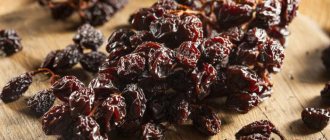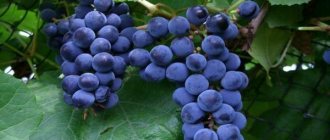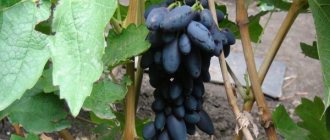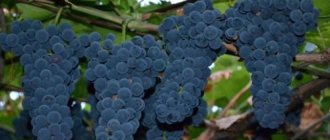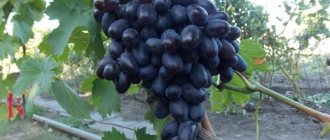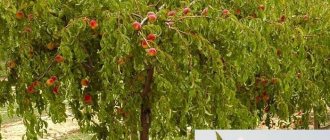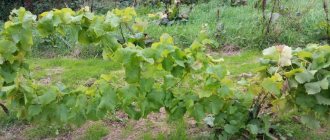| Place | Name | Characteristics in the rating |
| The best grape varieties for uncovered cultivation in the Moscow region |
| 1 | Valiant | Better frost resistance |
| 2 | Aleshenkin | High yield |
| 3 | Jupiter | Long term storage |
| 4 | Alpha | The tallest variety |
| The best technical grape varieties for the Moscow region |
| 1 | Crystal | Best quality |
| 2 | Isabel | The most popular variety |
| 3 | Cabernet Sauvignon | Big harvest. Pleasant taste |
| 4 | Amursky | Easy to care for |
| The best table grape varieties for the Moscow region |
| 1 | Queen of the Vineyards | The best dietary variety |
| 2 | Cardinal | Best taste |
| 3 | Timur | Excellent endurance |
| 4 | Gorgeous | Large berries |
| The best universal grape varieties for the Moscow region |
| 1 | Skuin's Anniversary | Presentable appearance. Juicy taste |
| 2 | Moscow white | Disease resistance |
| 3 | Pearl of the hall | Easy to transport |
| 4 | Friendship | Very sweet berries |
For many centuries, the fruit grape culture has been very popular among breeders and lovers of healthy berries. Crimea, Asia and the Caucasus are the territories in the Russian Empire where it was first grown. Thousands of years later, this fruit grows successfully both in the central zone of the country and in its North. The capriciousness of the plant and its heat-loving nature are not a hindrance today. Even amateur gardeners can grow a tasty product based on simple care rules.
When planting a fruit, you need to focus on its characteristics. For example, to grow in the Moscow region, a grape variety must have the following criteria: winter hardiness, good immunity to disease and early harvest. Many varieties of beautiful, and most importantly, tasty fruit are endowed with such qualities.
Types of grapes
Grapes Crystal
According to the method of consumption, grapes are divided into three categories:
Dining room. Berries of this type are eaten fresh without any processing.
- Anniversary of Novocherkassk;
- Kishmish Radiant;
- Tason.
Technical. Berries for processing (squeeze juice, make wine or compote).
- Alpha;
- Crystal;
- Isabel;
Isabel
Decorative. With the help of some varieties of grapes, you can decorate your garden by growing vines with beautiful leaves and fruits on special pergolas:
- Crystal grapes;
- Platovsky;
- Saperavi.
Taking into account all the characteristics of the climate and the characteristics of a particular type of crop, breeders develop many different varieties that bear fruit in regions with a cooler climate.
Top best
When choosing grapes, pay attention to the height and spreading of the bushes, the length of the vines, the weight of the berries and clusters, and color. Let's compile the top best grape varieties for the Moscow region, find out the advantages and disadvantages of each plant.
Buffalo
The ripening period is mid-early, the harvest is harvested in early September. The vines are long, with green middle leaves, and there is strong pubescence on the blades. The flowers are small and bisexual. The clusters are conical and loose, the weight of one varies from 200 to 500 g. The berries are oval-round, blue-black, with a waxy coating. The weight of the fruit is about 4 g, the pulp is dense and juicy, the taste is sweet, with a berry aroma. The fruits are suitable for fresh consumption and processing.
Buffalo is winter-hardy, can withstand temperatures down to -30°C, and is rarely affected by mildew and gray mold. It is planted not only for berries, but also for beauty: vigorous bushes with branching vines decorate gazebos, terraces, and country houses.
Aleshenkin's gift
The early table variety Aleshenkin is popular in all regions of the country. A medium-sized shrub with glossy emerald-colored leaves. The flowers are bisexual; the crop does not require pollinating insects. The clusters are large, wide-conical, the weight of one reaches 600 g. The berries are oval, light green, weigh about 3–5 g. The skin is thin, but durable, with a waxy coating. The pulp is tender and juicy, pleasant to the taste. Frost resistance - down to -26°C; some gardeners plant bushes in unheated greenhouses to protect them from frost. The purpose of the variety is universal: the fruits are suitable for transportation, processing, and storage.
Victoria
The Victoria variety can withstand temperatures down to -27°C and is successfully grown by breeders in the south, north and central zone of the country. The bushes are medium or low growing and do not take up much space on the site. The leaves are medium dark green, straight shoots grow quickly. The clusters are conical, medium density, ripening time - about 4 months. The berries are oval and dense, weight - 5 g. The color is red-raspberry, translucent in the sun. The flesh is crispy, the taste is sweet and harmonious. The skin is thin, the aroma is nutmeg. To prevent the berries from cracking, it is not recommended to over-moisten the soil.
Attention! Among the disadvantages of the variety, weak immunity to insect pests, especially wasps, is noted. To protect plants, the preparations “Aktara” or “Fastak” are used. Before use, it is important to familiarize yourself with the dosage and protective measures.
Jupiter
Jupiter ripens very early, harvesting in early or mid-August. Seedless fruits can remain on the bushes for 3-4 weeks without losing their taste and marketability. The clusters are cylindrical-conical, winged and loose, weigh 200–300 g. The berries are oval-round, blue-violet in color. The skin is strong, with a waxy coating, the pulp has a high sugar content, harmonious and aromatic. Jupiter bears fruit consistently in cool, humid weather. To increase yield, short pruning is carried out once a year. The harvest is suitable for drying, fresh consumption, and making wine.
The variety is resistant to mildew, powdery mildew and gray mold, and is rarely damaged by wasps, aphids and spider mites. A strong skin and a waxy coating protect the fruit from cracking.
Alpha
Technical frost-resistant Alpha grapes are used to make dry and sweet wine. The ripening period is average, the harvest is harvested at the end of August. The bushes are medium-sized, the vines are long and strong, the leaves are dark green. The clusters are cylindrical, with a small wing, medium density, weigh 300 g. The color of the fruit is black-violet, with a blue tint. Alpha's taste is sweet, with a slight sourness and a nutmeg aftertaste. The skin is medium thick, the aroma is pronounced. The crop is grown for processing berries and decorating the garden plot. Immunity to diseases and insect pests is above average.
Phenomenon
The ripening period of the table variety is about 120 days. The plant is unpretentious in cultivation, seedlings quickly adapt to climatic conditions. The bushes are tall, the leaves are large, matte dark green. The flowers are bisexual. The shape of the bunches is cylindrical-conical, the density is average. The berries are oval yellow-green, with a golden tint. The average weight of a bunch is 450 g, the weight of a berry is 5–7 g. The skin is dense, but you can’t feel the grapes when you eat them. The taste is pleasant, harmonious, with a refreshing taste and aroma. The grapes are suitable for all types of processing; after ripening they do not crumble or crack.
Attention! The phenomenon is not affected by mildew and rarely suffers from gray rot. To increase productivity and strengthen immunity, it is recommended to plant the plant in spacious and well-warmed areas. In shade or partial shade, the crop bears fruit poorly.
Valiant
Juicy Valiant grapes came to Russia from the USA. The ripening period is mid-early, fruiting begins in the second ten days of August and continues until the end of September. The bushes are medium-sized, the foliage is dense. The clusters are small, the average weight is 150 g. The berries are small, black and blue in color, the flesh is dense, with a large seed. The taste is interesting strawberry, with a taste of the famous Isabella wine. The berries are suitable for transportation and processing - desserts and drinks are prepared from Valiant. The vines are beautiful and long, suitable for decorating a gazebo. The variety is easy to grow and does not require shelter for the winter. Immunity is high.
Helios
The Helios variety is early ripening and universal in use. The bushes are medium-sized, the leaves are large and light green. There is slight pubescence on the plates. The clusters are large, conical, with an average weight of 500 g. The berries are fleshy, oval, with a dense peel and juicy pulp. The taste is pleasant sweet, the juice is colorless. The fruits are used for fresh consumption and processing. Used for transportation, storage and sale. The variety is winter-hardy and drought-resistant; it does not require special skills to grow.
Lyubava
Very early table variety. It is distinguished by strong immunity to diseases and pests, unpretentiousness, and frost resistance down to -28°C. The bushes are medium-sized, the leaves are large and wrinkled, the flowers are bisexual. The clusters are conical or conical-cylindrical depending on growing conditions.
The berries are oval, white, transparent. The pulp is very tasty and juicy, with a nutmeg aroma. The juice is colorless, the seeds are small, the skin is medium thick. Juices and cocktails, marshmallows and marmalades, jams and compotes are prepared from table grapes.
Features of growing grapes in the Moscow region
Growing grapes in the Moscow region is somewhat different from growing in warmer areas. First of all, shelter for the winter is required (except when the grape variety is not covered), the formation of the vine, the application of fertilizers, and soil moisture.
To get a good harvest every year, you should follow some rules:
- choose winter-hardy, ultra-early varieties;
- plant next to fences to protect young plants from the winds;
- adding potassium and phosphorus;
- autumn pruning;
- shelter for the winter.
These are the basic rules for growing grapes in the Moscow region.
Shaping and trimming
In the Moscow region, pruning of grapes for shaping purposes begins in the second year after planting.
Attention!
In the first year, it is better not to touch young bushes. You are only allowed to tie it up if necessary to prevent it from falling.
Top dressing
The grapes are responsive to fertilization. Especially loves phosphorus and potassium. The first promotes the formation of buds, and potassium improves protective properties and stimulates growth.
The crop can be fed infrequently with manure once every 3 years for digging. 1 bucket is enough for 1 m2.
Early grapes for the Moscow region and St. Petersburg
Watering
Watering grapes is especially necessary when the fruits are ripening. It is customary to water early varieties three times a season, and mid- and late-ripening varieties - four times. However, this is not very effective. It is preferable to water once every 14 days. The irrigation depth is 50 cm.
Spraying
Spraying with Bordeaux mixture is suitable as a preventative measure. Helps well against mildew and oidium. It is useful to spray grapes with fungicides.
Wintering
Proper preparation for shelter is important. They start by pruning the grapes after the leaves fall. If the vine is on a trellis, it is also removed and secured to the ground with metal staples.
Attention!
The shoots should not come into contact with the ground to prevent rotting. Therefore, planks of wood or slats are placed under the vine.
You can cover it with film, spruce branches, roofing material, agrofibre. After covering the old bushes with the material, they are additionally wrapped with twine.
Harvesting
The harvest is harvested in late summer - early autumn. It is recommended to harvest on time, despite the fact that ripe bunches can hang for a whole month.
Reviews
Inna
Planting grapes in the Moscow region is a thankless task, there is a lot of hassle, and the harvests are weak. It was like that before! Now choose, I don’t want to. My first experience was Jupiter, then Crystal, the third was the Beauty of the North. All are developing perfectly, they are ripening on time, the hands are fully ripened. My bushes are already mature, I don’t cover any of them for the winter.
Valery
In the Moscow region, it is better to plant grapes in the spring (after return frosts), so that the seedlings more or less take root before autumn. I have been growing northern Saperavi for about 9 years, I let it grow around the gazebo, its beauty is indescribable. Now I’m just selecting another variety, looking at it from the canteens. Preventive treatments are mandatory; I spray twice before flowering, in mid-summer and after harvest.
Climate of the Moscow region and its features
To choose the right grape variety for cultivation, it is necessary to take into account the peculiarities of the Moscow region climate. There are grapes that will grow well in such conditions, without wasting time and effort.
The first feature of the climate is the long spring. Therefore, common growing schemes may not be suitable. In the Moscow region there is a dry beginning of summer and a rainy second half. Accordingly, you need to make adjustments to watering.
Helpful information!
The advantage of the climate is that there are no insects that can harm grape plantings. There are still no strains of some crop diseases.
In winter there is a lot of snow. Precipitation covers the vine with a dense layer, thereby protecting it from freezing.
Collection of the best grape varieties for the Moscow region and the middle zone
Varieties compatibility
To get a good harvest, summer residents carefully select varieties of berries, which they plant next to each other. For example, Alcor gets along well with the White Sauvignon variety - both are medium-late, together they enter the phases of flowering, berry set, and fruiting. The ripening period is one of the main signs that it is recommended to pay attention to. If early and late ripening grapes are planted nearby, they will develop differently, which will negatively affect the yield. While one variety is finishing flowering, another is just beginning.
It is important to take into account the type of soil and climatic conditions in which the grapes consistently bear fruit. For example, Skungub 2 is frost-resistant and takes root in cold regions of the country. The Yubilei Skuinya grape, which has similar characteristics, is planted next to it. It is not recommended to place southern and northern varieties in the same area - they are accustomed to different growing conditions, and such plants will not be successful in proximity.
Attention! Disputes do not subside among summer residents: some believe that technical varieties are planted only next to industrial varieties, and table varieties - with table varieties. Other gardeners claim that these types of grapes get along well with each other. There is no consensus on this matter.



